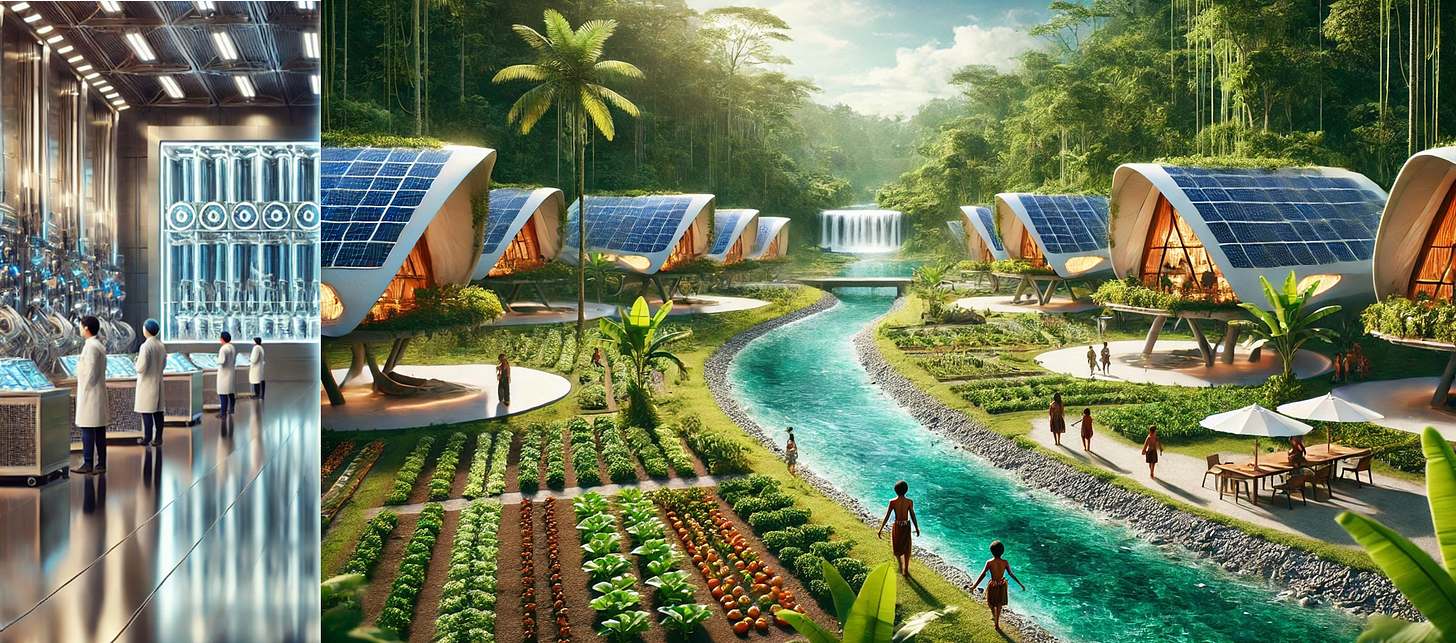The fork in the climate path
In the heart of a bustling global climate conference, Emma, a sustainability expert, found herself at a crossroads. On one side of the exhibit hall stood dazzling models of futuristic machines, their promises of Negative Emission Technologies (NETs) gleaming under bright lights and emblazoned on banners. On the other side was the serene, earthy display of OXÏ-ZEN's Carbon Balance approach, showcasing an indigenous community living alongside a vibrant forest, where farming practices harmonize with nature to maintain a delicate balance.
The Allure of NETs
Emma wandered first toward the NETs booth, drawn by the promise of innovation.
“Imagine this,” said a polished presenter in a crisp suit. “Our machines pull CO₂ directly from the air, sequestering it in underground storage. It's the cutting edge of climate science, engineering our way out of the crisis.”
The glossy brochures laid out a range of NETs:
Direct Air Capture with its futuristic machines.
Bioenergy with Carbon Capture and Storage (BECCS), combining energy production with carbon removal.
Enhanced weathering, where minerals absorbed CO₂ from the atmosphere.
Ocean alkalinization, a bold attempt to harness the seas.
The graphs were impressive, showcasing potential reductions in billions of tons of carbon annually. Yet as Emma dug deeper, the challenges emerged. Direct Air Capture, while powerful, required enormous energy and infrastructure investments.
BECCS raised ethical concerns about land use, competing with food crops, or threatening natural habitats.
Enhanced weathering and ocean alkalinization were still experimental, with ecological risks yet to be fully understood.
“It’s promising,” Emma admitted, “but what about the social and environmental trade-offs? Can we truly rely on these technologies to tackle the crisis at scale?”
The Simplicity of The Art of Carbon Balance
Curious, Emma moved next to the OXÏ-ZEN booth. The contrast was striking. Here, the focus wasn’t on futuristic machines but on nature and communities. David, a representative, greeted her warmly.
The display featured real-life stories: a community in South America revitalizing degraded land, and detailed diagrams illustrating the process of carbon sequestration in natural carbon sinks, how the emissions or carbon footprints of emitters (buyers) are calculated, and how emitters are directly connected to converters, the guardians of these natural carbon sinks.
“Unlike NETs,” David explained, OXÏ-ZEN’s Carbon Balance isn’t about building giant machines to extract carbon. It’s about working with nature’s existing systems and the people protecting them.
Emma studied a map showcasing global carbon sinks: forests, peatlands, and national parks, each tied to a story of local stewards engaged in true-value economic transactions with emitters.
“But how is this different from simply offsetting carbon?” she asked.
David smiled. “Traditional offsets are often criticized for being vague, with often contradicting methodologies, and difficult to verify. Our approach uses scientifically validated methods that are independently verifiable, together with transparent data integrity using blockchain technology. Emitters can now carbon-balance specific carbon footprints, such as products and services, offering their clients carbon-balanced goods and services.
On the other side, our converters (owners of the carbon sinks) are thus empowered to invest in sustaining natural ecosystems for the long term, guaranteeing the protection, enhancement, and expansion of natural carbon sinks with positive impacts on biodiversity, water management, and microclimates, while enabling critical investments in rural infrastructure, health care, and education. In the end, we’re taking about positive social impact with improved quality of life. Its about restoring balance with natural systems.
Choosing the path forward
By the end of the day, Emma stood at the crossroads. NETs dazzled her with cutting-edge innovation but came with steep costs, heavy energy demands, and a reliance on future breakthroughs. In contrast, OXÏ-ZEN’s Carbon Balance offered a grounded, community-driven solution that works today, protecting ecosystems while uplifting communities.
“Perhaps,” Emma thought, “the real path forward isn’t just about technology or nature alone but finding harmony between the two. But for now, OXÏ-ZEN feels like the solution that bridges urgency with impact.”
As she left the exhibit hall, Emma wasn’t just thinking about choices for industries. She smiled as she was envisioning a future where technology and nature coexist. A world where solutions like The Art of Carbon Balance by OXÏ-ZEN led the way toward a sustainable tomorrow.




